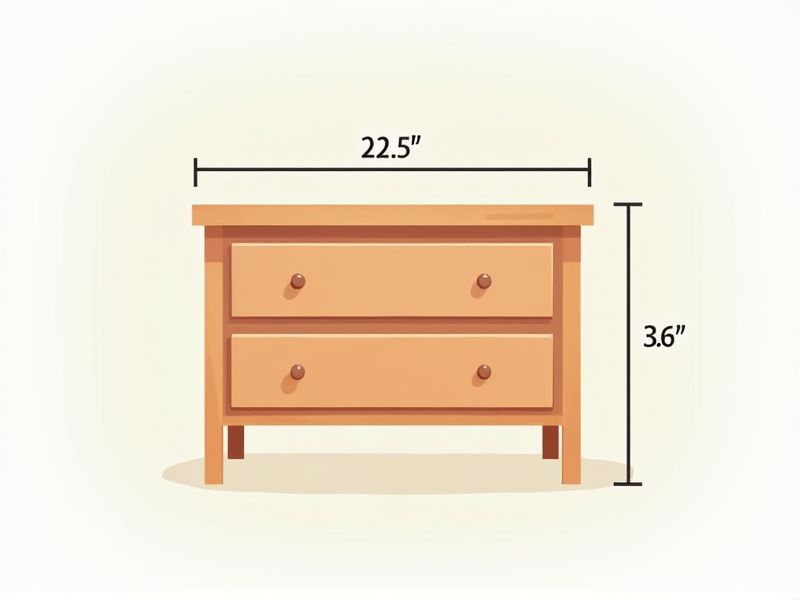
When choosing a dresser, understanding standard dimensions can help you find a piece that fits your space and storage needs. Most dressers are typically between 30 to 50 inches high, 30 to 70 inches wide, and 15 to 20 inches deep. For example, a common six-drawer dresser often measures around 36 inches high, 60 inches wide, and 18 inches deep. Measuring your available space carefully before shopping ensures that the dresser will function well in your room and provide the storage you need.
Width
When selecting a dresser, the standard width typically ranges from 30 to 60 inches, catering to various room sizes and storage needs. A wider dresser, approximately 50 to 60 inches, offers increased drawer space, ideal for organizing clothing and accessories efficiently. Conversely, a narrower dresser, about 30 to 40 inches, can fit comfortably in compact areas, making it suitable for apartments or smaller bedrooms. Ensure your chosen dresser complements your room's layout while maximizing your storage potential effectively.
Height
A dresser typically stands between 30 to 50 inches in height, catering to various storage needs and bedroom designs. For optimal accessibility, the ideal dresser height for most individuals is around 36 inches, allowing easy reach to drawers without excessive bending. Taller dressers, often exceeding 50 inches, can maximize vertical space in smaller rooms, while low dressers provide a contemporary look that can double as a display surface. When selecting a dresser, consider your own height and the height of your bed to ensure a cohesive and functional bedroom setup.
Depth
A standard dresser typically measures about 16 to 20 inches in depth, providing ample space for organization while maintaining a compact footprint. This depth allows for easy access to clothing and personal items, making it practical for daily use. Many designs incorporate multiple drawers, often ranging from three to eight, to enhance storage efficiency and cater to diverse needs. When selecting a dresser, consider how the depth aligns with your available space and storage requirements for optimal functionality.
Number Of Drawers
A standard dresser typically features between 5 to 8 drawers, providing ample storage for clothing and accessories. The most common configurations include two small top drawers for items like socks and accessories, combined with larger bottom drawers for bulkier clothing. A dresser with a total height of 30 to 36 inches offers an accessible design, suitable for various room layouts. You can maximize your space by selecting a dresser that complements your storage needs while ensuring an organized and aesthetically pleasing environment.
Drawer Width
A standard dresser typically features drawer widths ranging from 24 to 36 inches, optimizing space for organization and storage efficiency. The width of each drawer affects how much clothing or accessories you can store, with deeper drawers accommodating bulkier items like sweaters or jeans effectively. When selecting a dresser, ensure that the drawer width aligns with your storage needs, providing easy access to your belongings. Consider that an ideal drawer should comfortably extend outwards, with an internal depth of at least 14 to 18 inches, allowing for maximum functionality.
Drawer Depth
The standard drawer depth for dressers typically ranges from 12 to 16 inches, allowing for efficient storage of clothing and accessories. Taking into account the overall height of dressers, which is usually between 30 and 60 inches, the enhanced depth ensures that items can be easily accessed without the risk of overcrowding. By maximizing drawer depth, you can better organize your belongings, improving both accessibility and maintaining a clutter-free space. When selecting a dresser, consider your storage needs and the size of your items to optimize functionality and aesthetics in your room.
Drawer Height
A standard dresser typically features drawer heights ranging from 6 to 10 inches, allowing for versatile storage of clothing and accessories. The overall design usually includes multiple drawers, with vertical configurations maximizing space efficiency in your bedroom. Commonly, dressers stand between 30 to 52 inches in height, integrating seamlessly with other furniture pieces. Consider a dresser that aligns with your specific height preference for both aesthetics and functionality.
Material Thickness
A dresser's standard typically emphasizes material thickness, which plays a critical role in durability and overall quality. High-grade materials often range from 0.5 inches to 1 inch thick, providing optimal sturdiness that supports weight and ensures longevity. For instance, a solid wood dresser with a thickness of 0.75 inches generally offers better resistance against warping compared to thinner alternatives. Investing in a dresser with appropriate material thickness enhances not only the aesthetic appeal of your space but also the functionality of the unit.
Leg Height
When selecting a dresser, leg height plays a crucial role in both aesthetics and functionality. Standard leg heights typically range from 4 to 10 inches, impacting the overall visual appeal and ease of access to items stored inside. A dresser with legs shorter than 4 inches may create a more compact look, while those exceeding 10 inches can enhance air circulation and make cleaning underneath easier. Consider your personal preferences and the dimensions of your space to ensure your dresser complements your bedroom design effectively.
Mirror Attachment Height
When selecting a dresser, consider the mirror attachment height, which typically ranges from 60 to 75 inches above the floor. This height ensures optimal visibility and convenience for most users, allowing you to comfortably view your reflection while standing or seated. For a more customized experience, adjust the mirror to align with your natural eye level, usually around 5 to 6 inches above the dresser's top surface. Remember, the right mirror height can enhance the overall functionality and aesthetic of your bedroom space.
